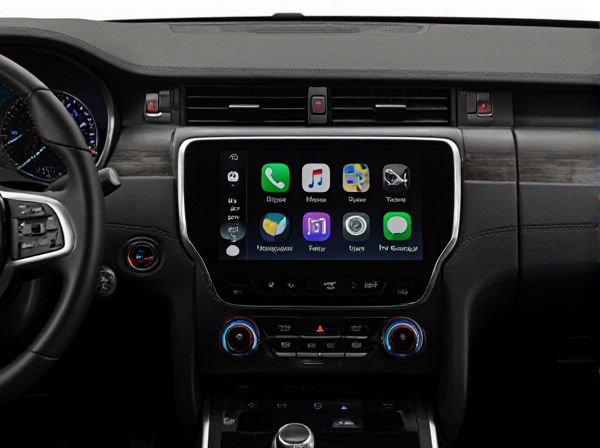
Photo illustration: Touchscreen Infotainment vs Physical Control Infotainment
Touchscreen infotainment systems offer a modern, sleek interface that allows You to access navigation, media, and settings with intuitive swipes and taps, enhancing vehicle aesthetics and functionality. Physical control infotainment provides tactile feedback and ease of use without distraction, enabling drivers to operate features by feel, which can improve safety and precision while driving. Balancing both systems can optimize user experience by combining responsiveness of touchscreens with the reliability and simplicity of physical buttons.
Table of Comparison
| Feature | Touchscreen Infotainment | Physical Control Infotainment |
|---|---|---|
| User Interface | Digital, customizable, multi-touch support | Buttons, knobs, tactile feedback |
| Ease of Use | Intuitive for tech-savvy, requires focus | Simple, can operate without looking |
| Safety | Potential distraction, minimal tactile feedback | Enhanced safety due to tactile controls |
| Responsiveness | Depends on software, may lag | Instant physical response |
| Maintenance | Software updates, screen repairs | Durable, mechanical parts may wear |
| Compatibility | Supports smartphone integration, apps | Limited smartphone features |
| Cost | Higher initial cost, advanced tech | Lower cost, simpler technology |
Introduction to Infotainment Systems
Infotainment systems integrate entertainment and information features in vehicles, enhancing driver experience through user-friendly interfaces. Touchscreen infotainment offers dynamic interaction with easy access to navigation, media, and smartphone integration, prioritizing modern digital connectivity. Physical control infotainment relies on tactile buttons and knobs, providing intuitive, distraction-free operation favored by users seeking straightforward feedback and minimal learning curves.
Evolution of Car Infotainment Interfaces
Car infotainment interfaces have evolved from basic physical controls such as knobs and buttons to advanced touchscreen systems that offer enhanced interactivity, customization, and integration with smartphone technologies. Touchscreen infotainment enables seamless access to navigation, media, and vehicle settings through intuitive gestures, while retaining physical controls still provide tactile feedback and ease of use without visual distraction. The progression reflects a balance between user convenience, safety, and technological innovation driving modern automotive user experience.
User Experience: Touchscreen vs Physical Controls
Touchscreen infotainment systems offer a modern, visually intuitive interface with customizable displays, but they can cause distraction due to the need for precise touch input and lack tactile feedback. Physical control infotainment provides haptic feedback and easier operation by feel, enhancing safety and reducing driver distraction during vehicle operation. User experience strongly depends on balancing ease of use, feedback, and minimizing attention diversion for optimal in-car interaction.
Safety and Driver Distraction
Touchscreen infotainment systems often lead to increased driver distraction due to the need for precise, visual interaction, which can divert attention from the road, increasing the risk of accidents. Physical control infotainment systems enable tactile feedback, allowing drivers to operate controls by feel without looking, thus reducing cognitive load and enhancing safety. Studies show that physical buttons minimize task completion time and improve focus, making them a safer option in driving environments.
Accessibility and Usability
Touchscreen infotainment systems offer a sleek, modern interface with customizable layouts, but they often require precise touch inputs that can be challenging for users with limited dexterity or vision impairments. Physical control infotainment systems provide tactile feedback through buttons and knobs, enhancing accessibility by allowing users to operate controls by feel without diverting attention from driving. Usability studies indicate that physical controls tend to reduce driver distraction and improve ease of use, especially in situations requiring quick adjustments or while wearing gloves.
Customization and Feature Flexibility
Touchscreen infotainment systems offer extensive customization and feature flexibility through software updates, customizable interfaces, and integration with smartphones, allowing users to tailor experiences to their preferences. Physical control infotainment systems, while less adaptable, provide tactile feedback and intuitive access to essential functions, enhancing usability without extensive customization options. Advanced touchscreen platforms support multi-functional controls and third-party apps, expanding functionality beyond the fixed layout of traditional physical control interfaces.
Reliability and Maintenance
Touchscreen infotainment systems offer sleek interfaces but can suffer from delayed responsiveness and increased likelihood of software glitches, impacting reliability. Physical control infotainment systems, featuring tactile buttons and knobs, tend to provide more consistent performance with lower failure rates due to simpler mechanics. Maintenance demands are higher for touchscreens since firmware updates and touch panel replacements are often necessary, while physical controls mainly require occasional cleaning or button replacement, enhancing long-term durability.
Cost Implications for Manufacturers and Consumers
Touchscreen infotainment systems often incur higher production costs due to advanced display technology and complex software integration, which can lead to increased prices for consumers. Physical control infotainment systems typically cost less to manufacture, benefiting from simpler components and lower development expenses, thus offering a more budget-friendly option for buyers. Manufacturers balance these cost implications by evaluating consumer preferences, production scalability, and potential maintenance expenses associated with each system type.
Future Trends in Infotainment Technology
Future trends in infotainment technology emphasize seamless integration of touchscreen interfaces with advanced voice recognition and haptic feedback, enhancing user interaction and safety. Physical control infotainment systems persist due to their tactile reliability and ease of use during driving, motivating hybrid designs that combine touchscreens with traditional knobs and buttons. Innovations in AI-driven personalization and connectivity will further blur the lines, enabling adaptive infotainment experiences tailored to individual driver preferences and real-time contexts.
Conclusion: Choosing the Right Infotainment System
Selecting the right infotainment system depends on user preference and driving context, with touchscreen systems offering modern, intuitive interfaces and seamless smartphone integration, while physical control infotainments provide tactile feedback and easier operation without diverting attention from the road. In vehicles prioritizing safety and minimal distraction, physical buttons and dials remain advantageous, whereas touchscreen systems excel in customizable features and aesthetic appeal in luxury or tech-focused models. Understanding the balance between usability, safety, and technological capabilities ensures an informed decision aligned with individual needs and driving habits.
 caratoz.com
caratoz.com